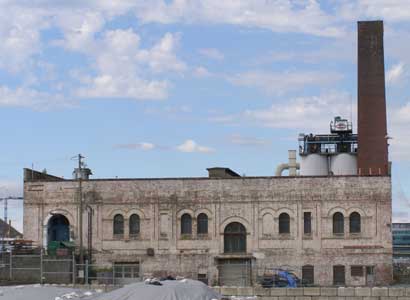Heritage Register
Burnside
2110 Store Street
The Powerhouse
Built
1892
Heritage-Designated 2012
For: National Electric Tramway & Light Company
Architect: John Teague

ARCHITECTURE:
This is a large, two-storey, flat-roofed, Romanesque-style, commercial brick building. The front façade has a round-arched entrance at the extreme left end. The building to the right of this has a symmetrical upper floor with two pairs of round-arched windows either side of a large round-arched window under a panel dated 1892. All the openings have pilasters below the arches, the far left entry having the most elaborate. The bays are separated by brick pilasters. The basement level has two large entrys, and segmentally-arched windows. Because of the sloping site, the basement beyond the entrance bay is at ground level. A broad band of plain parging at roof level suggests a lost metal frieze. The narrow metal capping survives. A tall square smokestack at the rear right corner is missing its original corbelling. The right and left sides of the roof are parapetted.
ORIGINAL OCCUPANTS:
Designed by John Teague, mayor and architect of City Hall, The Powerhouse was built for $15,000 to generate electricity for the tram network (502-08 Discovery St, Burnside), after an earlier plant burned. VDC reported August 8, 1892 that it was to be a “substantial structure of stone, brick and iron.” The company became Victoria Electric Railway Co in 1895 shortly before an overloaded streetcar caused the Point Ellice Bridge to collapse, on May 26, 1896. The company then became Consolidated Railway Co but soon folded. Sir Frank Barnard (1462 Rockland Av, Rockland) and R.M. Horne-Payne had formed British Columbia Electric Railway Co in 1892 and BCER took over the powerhouse. They stopped producing electricity soon after WWI, and dropped “Railway” from the name by 1951. The Powerhouse was converted to produce coal gas, until 1955. Natural gas conversion began, and much of the powerhouse was used as workshops. Part of the second storey became a gymnasium for employees. BC Hydro, which evolved out of BCE, for many years used it for its electric meter department. The powerhouse was vacant until a gas and boiler installation company, Apex Steel & Gas, moved into part of the building in 1989.
The Victoria Accord of 1993 earmarked prime waterfront land for a new art gallery, which would have made use of the building, However, the future of The Powerhouse is still uncertain, as an extensive soil remediation project continues.
ADDITIONAL INFORMATION & IMAGES:
• Statement of Significance (Canadian Register of Historic Places)
• Map of Victoria Heritage Register Properties
• Burnside History
• Burnside Heritage Register
• This Old House, Victoria's Heritage Neighbourhoods,
Volume Three: Rockland, Burnside, Harris Green,
Hillside-Quadra,
North Park & Oaklands

